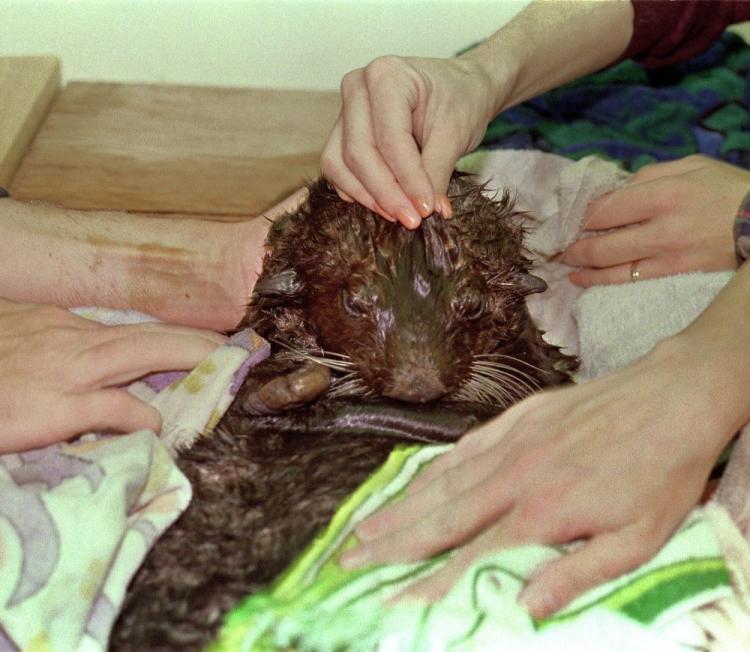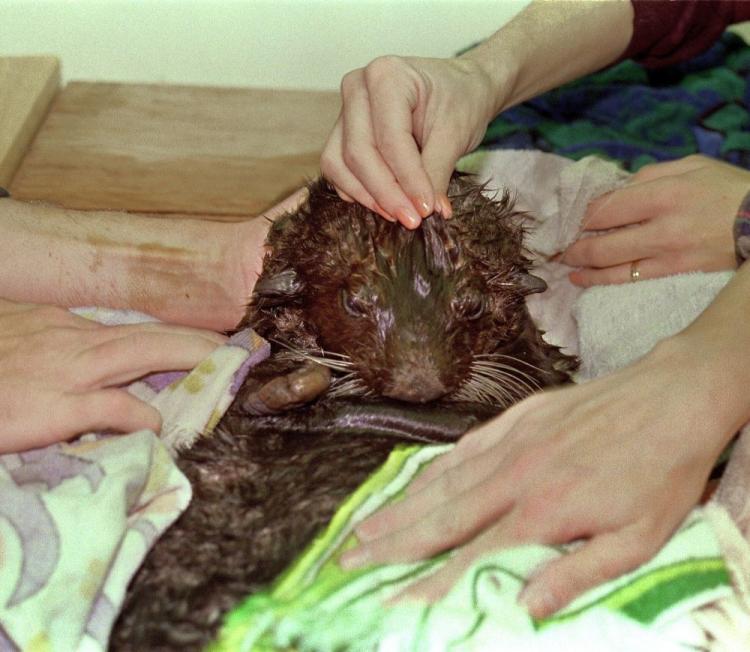Scientists have discovered that lingering oil from the Exxon Valdez spill is still being ingested by wildlife in Alaska more than two decades after the event.
Regarded as one of the most devastating environmental disasters in history, the Exxon Valdez ran aground in Prince William Sound on March 24, 1989, spilling more than 10.5 million gallons of crude oil. The oil eventually covered an estimated 2,100 miles of ocean, killing an array of wildlife and negatively impacting Alaska’s fishing industry and economy.
Led by Daniel Esler from the Centre for Wildlife Ecology at Simon Fraser University in British Columbia, a team of researchers from Canada and the United States used biomarkers to measure the effects of long-term exposure to the oil on local wildlife—in particular harlequin ducks.
Esler says one of the more remarkable findings of the study, which was published in the scientific journal Environmental Toxicology and Chemistry, is that animals are still being exposed to residual oil from the spill.
“That’s been the most surprising result of the body of research to date—basically knowing that the oil persists in the environment that long and wildlife continues to be exposed to it, so it is unanticipated.”
The team focused their research on harlequin ducks because the marine birds have several characteristics that make them particularly sensitive to oil pollution—one being their diet, said Esler.
“They eat invertebrates, little sea-animals that live in or on the substrate, and that’s part of the problem, because they’re probably disturbing the sediment as they’re foraging, which could release oil. Also, invertebrates don’t have the same mechanisms for metabolizing oil as vertebrates so they may accumulate oil and then it can get passed up the food chain to the ducks.”
In addition, harlequins, which live in inter-tidal and shallow sub-tidal areas, have a small body size when compared to other sea ducks.
The study found that oil levels were higher in the area of the Exxon Valdez spill than in nearby areas, a conclusion supported by multiple samples and two independent laboratories.
Esler said the research recognizes “that the duration of presence of residual oil and its associated effects are not limited to a few years after spills, but for some vulnerable species may occur over decades.”
The effects of the Exxon Valdez spill on both wildlife populations and communities have been debated by biologists, ecologists, and the oil industry in the years since it occurred.
In a study published in January, researchers at Temple University in Pennsylvania found that low concentrations of nutrients and oxygen in the lower layers of the beaches in Prince William Sound is impeding the biodegradation of the oil.
The researchers estimated that almost 20,000 gallons of Exxon Valdez oil still remains in the beaches.
Regarded as one of the most devastating environmental disasters in history, the Exxon Valdez ran aground in Prince William Sound on March 24, 1989, spilling more than 10.5 million gallons of crude oil. The oil eventually covered an estimated 2,100 miles of ocean, killing an array of wildlife and negatively impacting Alaska’s fishing industry and economy.
Led by Daniel Esler from the Centre for Wildlife Ecology at Simon Fraser University in British Columbia, a team of researchers from Canada and the United States used biomarkers to measure the effects of long-term exposure to the oil on local wildlife—in particular harlequin ducks.
Esler says one of the more remarkable findings of the study, which was published in the scientific journal Environmental Toxicology and Chemistry, is that animals are still being exposed to residual oil from the spill.
“That’s been the most surprising result of the body of research to date—basically knowing that the oil persists in the environment that long and wildlife continues to be exposed to it, so it is unanticipated.”
The team focused their research on harlequin ducks because the marine birds have several characteristics that make them particularly sensitive to oil pollution—one being their diet, said Esler.
“They eat invertebrates, little sea-animals that live in or on the substrate, and that’s part of the problem, because they’re probably disturbing the sediment as they’re foraging, which could release oil. Also, invertebrates don’t have the same mechanisms for metabolizing oil as vertebrates so they may accumulate oil and then it can get passed up the food chain to the ducks.”
In addition, harlequins, which live in inter-tidal and shallow sub-tidal areas, have a small body size when compared to other sea ducks.
The study found that oil levels were higher in the area of the Exxon Valdez spill than in nearby areas, a conclusion supported by multiple samples and two independent laboratories.
Esler said the research recognizes “that the duration of presence of residual oil and its associated effects are not limited to a few years after spills, but for some vulnerable species may occur over decades.”
The effects of the Exxon Valdez spill on both wildlife populations and communities have been debated by biologists, ecologists, and the oil industry in the years since it occurred.
In a study published in January, researchers at Temple University in Pennsylvania found that low concentrations of nutrients and oxygen in the lower layers of the beaches in Prince William Sound is impeding the biodegradation of the oil.
The researchers estimated that almost 20,000 gallons of Exxon Valdez oil still remains in the beaches.







Friends Read Free